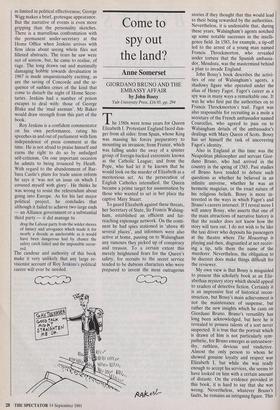Come to spy out the land?
Anne Somerset
GIORDANO BRUNO AND THE EMBASSY AFFAIR by John Bossy
Yale University Press, £16.95, pp. 294
The 1580s were tense years for Queen Elizabeth I. Protestant England faced dan- ger from all sides: from Spain, whose King was massing his forces preparatory to mounting an invasion; from France, which was falling under the sway of a sjnister group of foreign-backed extremists known as the Catholic League; and from the Pope, who had let it be known that he would look on the murder of Elizabeth as a meritorious act. As the persecution of English Catholics intensified, the Queen became a prime target for assassination by those who wanted to set in her place the captive Mary Stuart.
To guard Elizabeth against these threats, her Secretary of State, Sir Francis Walsing- ham, established an efficient and far- reaching espionage network. On the conti- nent he had spies stationed in 'above 40 several places', and informers were also active at home, passing on to Walsingham any rumours they picked up of conspiracy and treason. To a certain extent this merely heightened fears for the Queen's safety, for recruits to the secret service tended to be dubious characters who were prepared to invent the most outrageous stories if they thought that this would lead to their being rewarded by the authorities. Nevertheless, it is undeniable that, during these years, Walsingham's agents notched up some notable successes in the intelli- gence field. In 1583, for example, a tip-off led to the arrest of a young man named Francis Throckmorton, who revealed under torture that the Spanish ambassa- dor, Mendoza, was the mastermind behind a plan to invade England.
John Bossy's book describes the activi- ties of one of Walsingham's agents, a shadowy figure who operated undet the alias of Henry Fagot. Fagot's career as a spy was in many ways a remarkable one. It was he who first put the authorities on to Francis Throckmorton's trail. Fagot was also responsible for recruiting as a mole a secretary of the French ambassador named Courcelles, who agreed to pass on to Walsingham details of the ambassador's dealings with Mary Queen of Scots. Bossy has set himself the task of uncovering Fagot's identity.
Also in England at this time was the Neapolitan philosopher and servant Gior- dano Bruno, who had arrived in the country in the spring of 1583. Past studies of Bruno have tended to debate such questions as whether he believed in an infinite universe, whether he was an hermetic magician, or the exact nature of his religious beliefs. Bossy is more in- terested in the ways in which Fagot's and Bruno's careers intersect. If I reveal more I will annoy Bossy, who asserts that one of the main attractions of narrative history is that the reader does not know how the story will turn out. I do not wish to be like the taxi driver who deposits his passengers at the theatre where The Mousetrap is playing and then, disgruntled at not receiv- ing a tip, tells them the name of the murderer. Nevertheless, the obligation to be discreet does make things difficult for the reviewer.
My own view is that Bossy is misguided to present this scholarly book as an Eliz- abethan mystery story which should appeal to readers of detective fiction. Certainly it is an impressive feat of historical recon- struction, but Bossy's main achievement is not the maintenance of suspense, but rather the new insights which he casts on Giordano Bruno. Bruno's versatility has long been acknowledged, but here he is revealed to possess talents of a sort never suspected. It is true that the portrait which is drawn of him is not particularly sym- pathetic, for Bruno emerges as untrustwor- thy, ruthless, devious and vindictive. Almost the only person to whom he showed genuine loyalty and respect was Elizabeth I, but while she was ready enough to accept his services, she seems to have looked on him with a certain amount of distaste. On the evidence provided in this book, it is hard to say that she was wrong. Nevertheless, whatever Bruno's faults, he remains an intriguing figure. This book should be read by anyone who wishes to learn more about a man who possessed, as Bossy puts it, 'one of the most creative minds of the 16th century and possibly in the history of European thought and im- agination'.



















































 Previous page
Previous page